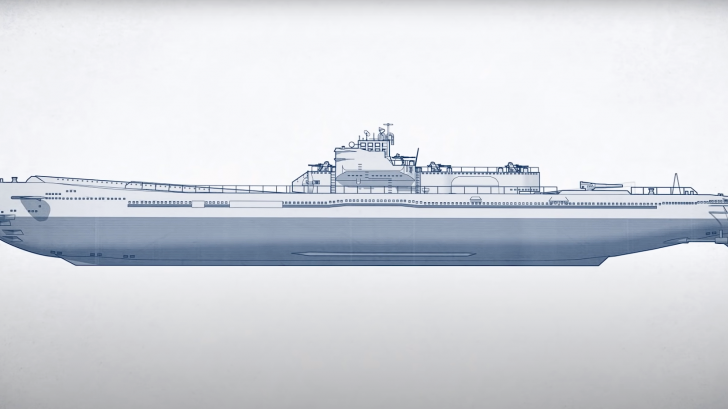A Hail Mary
The Japanese Navy needed a revolutionary weapon of mass destruction capable of turning the tides of the war. One such idea came in the form of a submarine that doubles as an aircraft carrier. Merging the stealth capabilities of a submarine and strike capabilities of carriers, the I-400 was already too good to be true at the time.
It had to be designed for a year and construction began in 1943 when Japan was already losing the war. A year ago, they just lost the Battle of Midway which weakened and shook their Navy forces. It wasn’t until 1944 when it entered the war and by then, it was already too late.
Ambitious Design
Japan wanted to fit planes inside a submarine and to do so, they had to make it even longer and wider. The I-400 was twice the length of a German U-Boat. The parallel cylindrical hull resulted in a displacement that tripled that of an American submarine.
To make things even spicier, they thought of ways to get the I-400 to go from Japan to the US in just one trip with no intentions of refueling. For that to work, millions of gallons of fuel were needed alongside ample amounts of food to last the crew.
Intended Capabilities
Five guns on the deck and eight forward-facing 533 mm torpedo tubes were rigged to the I-400. Four of the guns were anti-aircraft guns that used 25 mm ammo. The last was a 14 cm caliber naval gun for coastal defense.
Three dive bombers are expected to fit inside the submarine. These planes would then have to be launched in 30 minutes, go back down the ocean, wait for the bombers, and resurface again to hoist the planes back inside. Seems doable, right?
Newer Dive Bombers
But before doing that, Japan’s dive bombers weren’t suited for these missions and in such tight spaces. Therefore, Japan had to design a newer dive bomber that could fold its wings and could have floats attached under the fuselage. These bombers were capable of bringing any type of bombs and torpedos – but there were downsides.
Being built so late in the war, these planes were made using low-grade materials due to shortages. To add insult to injury, it was rare to see all three planes be ready for takeoff – usually, one or two would need additional time for maintenance.
Flawed Design
To streamline the takeoff from the I-400, compressed air catapults were used to launch the bombers. The intended time was supposed to be 30 minutes but it never took less than 45 for them to take off. Its massive design also meant the depth time was triple compared to American submarines. The hull was also riveted, not welded, which meant it faced problems against depth charges. Most of all, it was already way too late when it entered service. On the way to its first mission, Japan surrendered and the I-400 never got to live up to its expectations.
This video from Mustard has more information about the I-400-class submarine. Check it out below!



